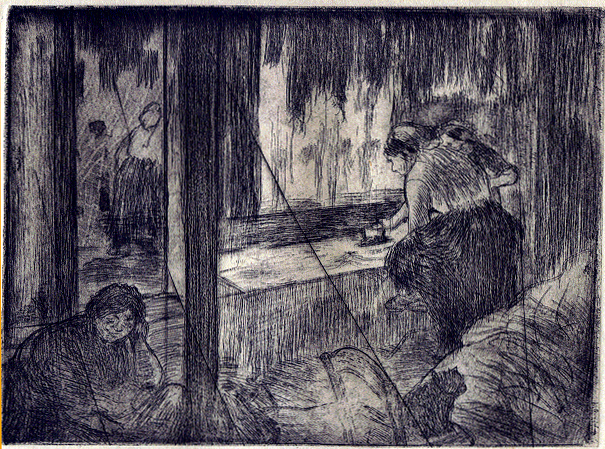
Whatever happened to what-s-his-name??? Well, now, that’s always been one of those questions best left unanswered. In the meantime, while you’re waiting, let’s tackle the biggest problem in marketing, which can be summed up as “The JUNO Principle:
“What’s the sense trying to scare people if they can’t even see or hear you?”
See, that is the problem. You can have the best item in the world, the most attractive advertising and promotion, but if nobody sees you or your ads or your product, it’s as if you were a tree falling in the forest, and you can quote me on that.
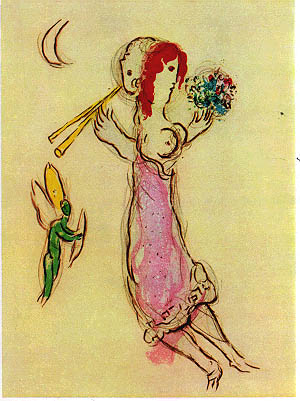
So how come “Phonetic” isn’t spelled “Fonetik”? Don’t bother to answer, I wouldn’t believe it in a million years whatever the claims may be. I’m a Language-Denier.
Marketing? Hey, it’s not about the product. It’s NEVER about the product. The customer knows nothing about the product and what’s more, doesn’t care. It’s not about trust. The customer hasn’t even seen your ad or your product or your face. It’s not about interest. There’s nothing in the customer’s face in which to be interested.
In a very real sense, you are invisible. You have no voice, no headroom, no media presence, and therefore you are not real in any sense of the word — you’re just a wish hoping to come true, a wisp blown by the wind and driven by the storm.
In short, you need to climb out of that human shell and get yourself a job in the Real World, not the world of organics and moveact code reaction.
Ordinary life can be compared to being shot into a pinball machine’s inner workings — ping, ping, ping, WHAM! Dink, dink, ping.poing.
Oh, never mind all that distractionary bullpuckey, we got work to do. The idea is to be of service in a totally disconnected society bristling with hate, suspicion and alarm.
Problem is, all the best seats have been taken, so when you want to open your own trading post, you can’t manage to squeeze in, and that’s the whole plan, to keep you down, which somehow keeps them up.
You need a way around that blockage, and the answer is simple but actually carrying it out is going to take some inner work on your part to overcome your natural tendency to screw it up.
None of that goes here — we can’t afford it. You’ll have to learn instantly how to survive the anonymity of it all.
You need to find a way to get to MILLIONS of people, and make them want to see more of whatever it is you’re offering, and as loyal fans, they’ll buy souvenirs, anywhere from a dollar up to millions, if it involves Elvis Presley’s limousine.
I have a sure-fire way to reach people with your product or service, but I only disclose it at our workshops, because it’s going to take a LOT of help to get you there, and you need the help of a TEAM, not just one individual, and that’s what it is, a team.
That means cooperation, not competition.
Once you’ve got the attention of a group of friendly folks, it’s time to whip out a few attractive goodies, but not to buy — to SELL, at a huge profit of DOUBLE what they paid!
That means they buy it at wholesale and sell it at retail, don’t let the fancy talk confuse you on the basic issues.
So you can set yourself simple achievable goals for each day, like “Today I’m going to show at least one person what I have to sell.”
Now, let’s uncomplicate the thing right here and now by limiting the sale to one cheap but desirable item, like a button or a magnet or a keychain. Keep it simple. Just one thing at a time.
Pick up the item in your hand. Feel it. Look at it. Examine it closely. What is it? What is it for? Why would anyone want one of these? Who would be likely to want one?
Go talk to them about it. Let them buy one as a souvenir of the interaction. Make it a point that you’ll call again when you find another goodie.
Don’t call any sooner than two weeks away — you don’t want to seem pushy, and there’s no reason you should — you’re not going to make a million bucks that way.
You need the internet, so you can reach thousands or tens of thousands of buyers, but you lose that human interaction and eye-to-eye contact that you get with a brick-and-mortar sale, so you have to make up for it by doing several things, one of which is to buff up your social media platform and get tens of thousands of followers and subscribers to your facebook page and other media outlets that you commonly use.
If you don’t use any, it costs nothing, and you guarantee that you won’t have to worry about order fulfillment or shipping or any of that bothersome stuff. Of course, along with that goes dire poverty, but I’m sure you’ve already thought of that as an option.
The problem is that anyone with the money to casually buy expensive art and jewelry will generally have no taste — they’re buying the thing for an entirely personal reason, that of aggrandizing, gathering the approval of monkeys, and in general, making a fuss over oneself while encouraging others to do the same.
The thing is, you have to sell either something very expensive once in a while, or a great many small cheap things every day, and the decision has to be made once and for all at the very beginning of your commercial enterprise, going where no donut-maker has gone before.
It’s not a question of being the first with a thing. If it’s cheap and worth making in China, you’ve got maybe two weeks before replacement junk arrives onshore — there are iPhones everywhere, and when a tourist takes a photo in your shop, be suspicious.
I didn’t make that up — it happened in New York City, where someone took photos of my jewelry, and it started appearing all over the place, manufactured in Thailand — needless to say, I never saw a penny.
For me, it’s no big deal — I’m not in it for the money. My total interest is getting YOU started not just in the marketing, but in the production of the artwork, and the sharing with other artists of similar persuasion.
It doesn’t have to be just art that you produce. I have some ancient art here that I’m offering, and they’re nowhere else to be found — they’re completely unique, as are several of my 17th century Rembrandts and 19th century Renoir and Degas lithographs and etchings.
The thing is, even if it’s the most incredible thing ever, if nobody ever sees it or hears about it or reads about it, it might as well not exist.
Whatever creative talent you have, it’s worthless without a public, and that means selfless public service.
For most of us, it for sure doesn’t mean “an enormous fortune in crypto currency” or “immediate worldwide acceptance and adulation”.
It mostly means making a living. If you hit a big sale every now and then, don’t let it lure you into taking more risk — if you’re not in it for the money, there’s no need to take risks.
For instance, you can create an art object, photograph it or scan it and drape that design across whatever product you have in mind and sell it for a small amount, because you have nothing in it but your time, effort and energy — and frankly, that isn’t worth much, right now.
Rest easy, it will, once you get the hang of how to put your stuff in people’s faces.
The real trick is to do it for nothing. Anyone with a billion dollars can get people’s attention, and 43 billion dollars will do it 43 times faster.
I’m starting my experimental marketing tool at an initial capitalization of $12.90, which I’ve been promised by a friend as soon as he gets paid, but since he has no job, he doesn’t know when exactly that will be, but count me in for twelve bucks, anyway.
So let’s bypass the problem for a minute, to see if we can get a glimpse around the bend…
What if we could get the attention of millions of viewers, readers, browsers — what would you present to them to buy right then and there?
How would you persuade them to buy it now, not wait a few weeks, months or years?
If you sold a single expensive item, what would you do next?
If you sold many cheap items, what would your next move be?
See, the trap is, there’s no end to the mountains over which the bear can go. No matter what happens, you’ll be forced to do it again, this time beating yourself at your own game, by coming up with something bigger, better, grander and more expensive, like a car manufacturer would do.
With the expensive thing, you automatically lose 99% of the viewers except as a matter of mild curiosity, and with the cheap thing, you lose the rich ones, the big fish.
Probably with your offering, it will appeal to neither.
What I mean is, there’s a small niche that MIGHT be interested in what you have to offer, but it’s highly unlikely that someone considered “normal” would ever think of buying it.
Small niche, eh? That suggests that I can narrow my search for viewers down to just a few dozen, maybe even a few hundred, views.
If what I’m selling is expensive enough, with a sufficient profit, I might just get it done and be able to repeat the experiment more times, maybe make a living from it, which means several sales every month.
You have to make a profit — to stay up with inflation — or you can’t replace your product, or ship the ones you sell.
Most art and collectibles buyers are buying with the idea that they’d flip it right away, and that whatever they’ve just bought is immediately worth at least double what they paid.
That’s not very likely, especially with the higher-priced rare pieces of art and treasure, which seldom offer more than a sliver of profit, and a lot of money tied up in the meantime.
You have a chance to buy museum-grade art which you should buy on the public’s behalf, then gift it to your local museum. There may be tax benefits to your estate by so doing, but the social and cultural benefits far outweigh personal wealth. This can be a legacy that you can leave for future generations. Here’s an example:
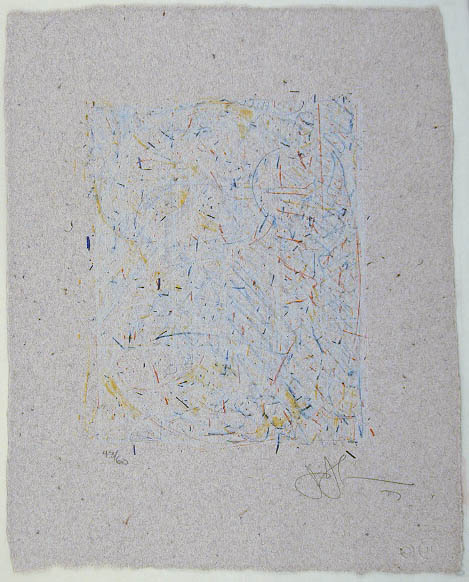 This is a very unusual form of Jasper Johns’ zero through nine series; it’s pencil-signed and numbered by the artist. It’s small, personal, and very, very limited in the edition size. JASPER JOHNS — Zero Through Nine (0-9) — color lithograph — Ca. 1978 — Edition 60 — Signed – Numbered – Dated – C 160×124 – S4 – G 781 – Full Margin — Sotheby New York – 05/13/87 – # 833.
This is a very unusual form of Jasper Johns’ zero through nine series; it’s pencil-signed and numbered by the artist. It’s small, personal, and very, very limited in the edition size. JASPER JOHNS — Zero Through Nine (0-9) — color lithograph — Ca. 1978 — Edition 60 — Signed – Numbered – Dated – C 160×124 – S4 – G 781 – Full Margin — Sotheby New York – 05/13/87 – # 833.
Here’s my own auction catalog description of the same piece: U188 JASPER JOHNS G779 0 THROUGH 9 Lithograph in colors on multicolored thread Mariposa paper, 1978, 162mm x 126mm — 6 3/8″ x 4 15/16″ — Full margin with deckled edges all four sides, no tears, no repairs, as issued thus. Pencil-signed JJohns lower right, pencil-numbered by the artist, 43/60 lower left below image area. Blindstamped. Ref: Sotheby’s New York Auction 11/02/99, LOT #1118. Listed in Gordon’s 2000, catalog #22869.
How much? I haven’t researched it yet, but the chances are that I’ll send this off to Sotheby’s rather than risk it on eBay. The reason is that only with several hours of research and some phone calls to dealer friends can I determine the actual market value of this rare signed Jasper Johns color lithograph. It could be a few thousand, tens of thousands or much, much more…you never know until you check it out, and this is not a piece that should be put in front of a casual crowd. Tracking the auction records will take at least ten hours of my time, even with Gordon’s Print Auction database, which I haven’t bought into yet, but at some point, I must. If this were to go into a charity auction, not a penny would accrue to the intended charity — I’ve seen the price on this go very, very high against powerful bidding, and it could happen again. Here’s another goodie:
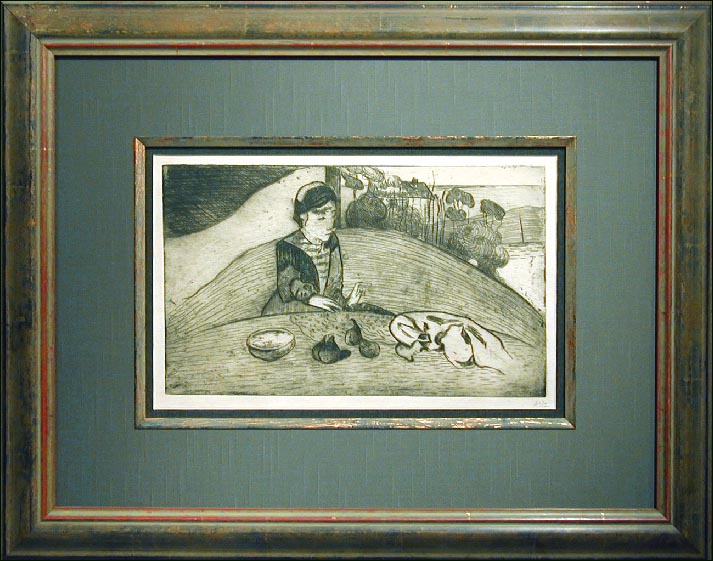
Paul Gauguin — La Femme Aux Figues (Guerin 88; Mongan, Kornfeld, Joachim 31 III/III). Original etching and aquatint (lavis) on softground zinc, 1899. First published in the portfolio GERMINAL in an edition of 100 impressions in greenish-gray ink, 268mm x 444mm. 10 additional impressions were made from the cut plate, which was reduced on the right side, down to 268mm x 418mm, by Madame Delatre, the printer’s widow. She then cancelled the plate by gouging 2 XX in the lower right of the cloth next to the figs. In 1966 the plate was purchased and many lighter, very imperfect impressions were made from it until the plate finally gave out, producing very gray, murky impressions, lacking the background cross-hatching and much of the drypoint and burin work.
Well, how about that??? Here’s a very valued print — Gauguin loved and produced woodcuts — he hated the etching process, and produced only the one example in his lifetime, and you can bet there’s a lot of controversy over that, but the fact that he did the platework has now been very fully examined and verified. You can easily determine which state this print might be by merely measuring the plate size and looking at the cross-hatching and other drypoint areas on the print, and determining whether the ink is green or black … at least I can, and that’s how I know what I’ve got here. How much is it worth? Gosh, that depends on so many factors…but the most important factor is the plate size — it happens to be the smaller size, but with no sign of the cancellation, which makes it one of the ten Madame Delatre made for herself. If I’m right, this impression would be worth well above the $7,500-$14,000 gallery prices realized by the most miserable of washed-out restrikes made in the 1960s. Let’s take a look at another item in my online gallery of fine art, all being offered to support the Interdimensional Underground Railway … I mean, of course, The Ashram. Take a look:
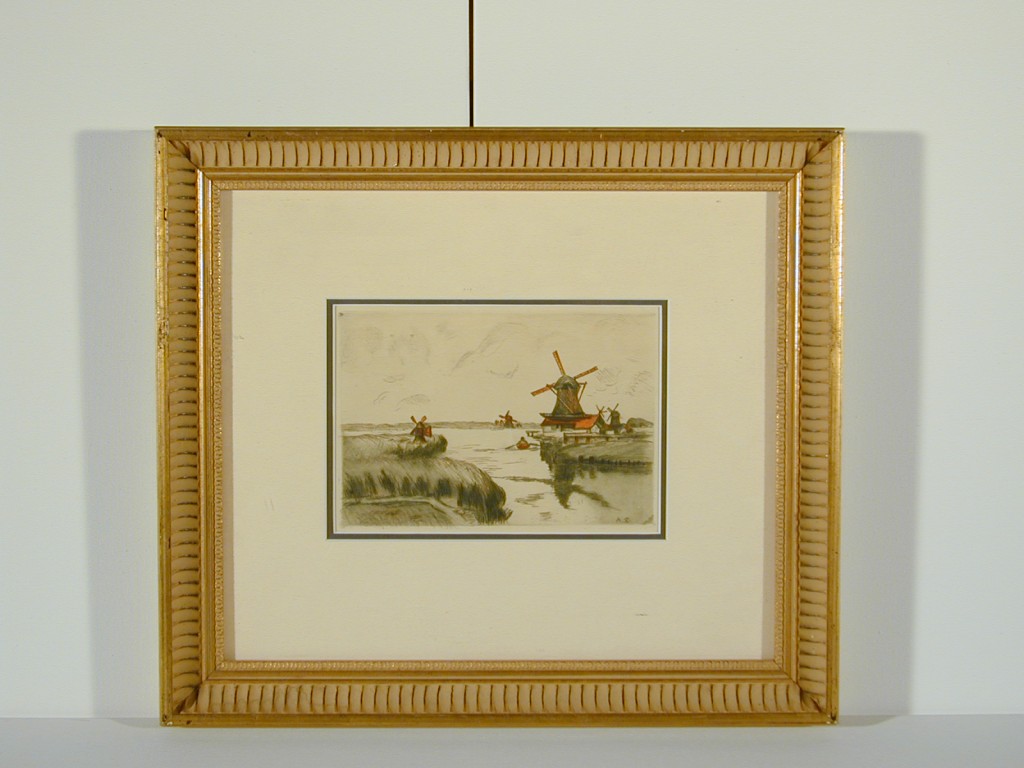
Guillaumin — Vue prise de Saardam — from Histoire des Peintres Impressionistes, Pissarro, Monet, Sisley, Renoir, Morisot, Cezanne, Guillaumin; Published by Theodore Duret in Paris, 1906. RARE thus. Later editions and impressions were made, but this is the original 1906 edition.
Price on this? Well, heck, you can get ’em cheaper if you don’t mind the later editions…I happen to prefer the earlier states, the earlier the better, and this is a rich, deep, dark impression. My price today would be $11,000, because that’s what I’d have to pay to get another, but that wouldn’t be quite fair… If I weren’t concerned with replacing it, which I’m not, because I have another in my private collection, a fair price in my gallery today would be $1,850. It was once part of a well-attended Impressionists exhibition in California.
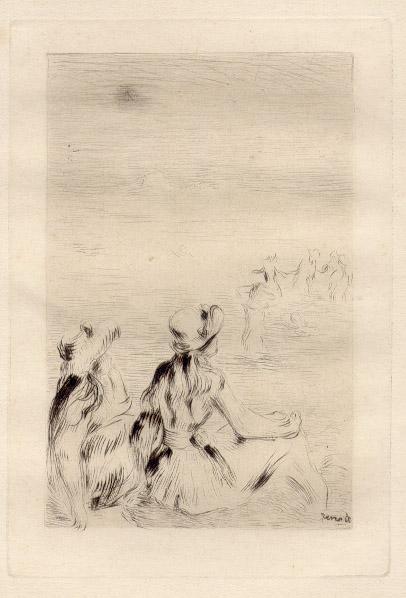 If you’re a Renoir fan, I don’t even have to tell you about this incredibly famous etching, but look carefully — you’ll see the bathers clearly, out in the water. Note that fact, because it says to you that this is a FIRST STATE impression, and that adds tens of thousands of dollars to the value. Want to know more about this? Fair enough, I’ll enter the data in:
If you’re a Renoir fan, I don’t even have to tell you about this incredibly famous etching, but look carefully — you’ll see the bathers clearly, out in the water. Note that fact, because it says to you that this is a FIRST STATE impression, and that adds tens of thousands of dollars to the value. Want to know more about this? Fair enough, I’ll enter the data in:
PIERRE-AUGUST RENOIR — SUR LA PLAGE, A BERNEVAL — First State before the plate was reduced (there’s one clue as to which state this is), plate size 180mm x 140mm. VERY RARE in First State, with bather in the right middle portion of the water, just beside the major figures in the composition. The bather is significantly missing in the 2nd and 3rd States, thus firmly identifying this impression as belonging to the 1st State. Strong drypoint and burr on hair, under hat of right figure and on front and back of crown of hat on left figure and on bather in water indicate a VERY EARLY impression in the First State, extremely rare thus. SIGNED Renoir lower right, about 1.5mm above plate edge. FULL MARGIN on untrimmed paper, with original binding evident on left, with remnants of original binding thread lower left. A very important early impression of a major work, seldom seen on the open market, and definitely a candidate for museum donation either now or later. My gallery price-tag on this is $38,500, but I have others far less expensive if you don’t care about the rarity factor.
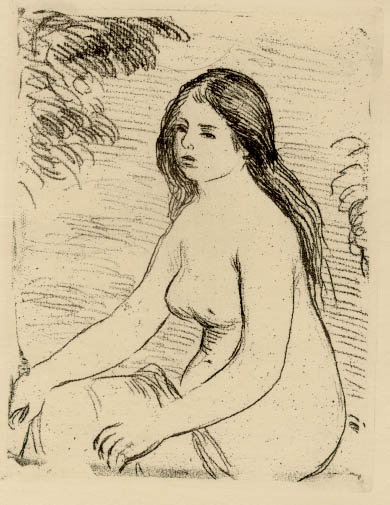
PIERRE-AUGUST RENOIR — FEMME NU ASSISE — Stella 12 — Softground etching, about 1906, Only State. 188mm x 149mm on full margin stock, 195mm x 256mm FROM THE FIRST EDITION. This softground etching was produced in Theodore Duret, L’Histoire des Peintres Impressionistes, Paris, Floury, 1906, facing page 106. The original foolscap separator with title comes with this RARE etching. Impressions were on HOLLAND paper (this is one of those) and a small number were printed in sanguine ink on Japan Paper for the Deluxe Edition. This is the EARLIER EDITION. It was later republished and bound-in to another book, Die Impressionisten, Theodore Duret, Berlin, B. Casirer, in 1909, but this is not that later edition. RARE thus.
My gallery tag on this is $8,500, but I might bring that up significantly, because there are no early impressions out there, just 1909 edition material, plus the usual grotesque restrikes made from the tired, well-worn — but still existing — etching plate at the Louvre in Paris. This is no restrike, no 1909 later edition. This is the real thing, museum-grade, not at all available to the general public. Okay, just one more Renoir, okay???
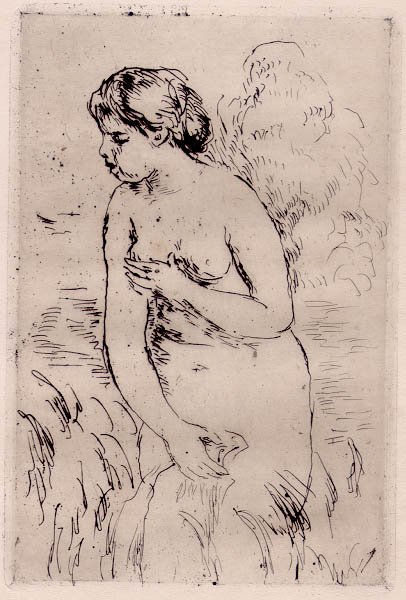
PIERRE-AUGUST RENOIR — BAIGNEUSE DEBOUT A MI-JAMBES. Etching, about 1910. Only State. 168mm x 112mm. Published by Theodore Duret and bound-in to Manet & the French Impressionists, London, G. Richards, 1910; then in Theodore Duret, L’Histoire des peintres impressionistes, 2nd Edition, Paris, Floury, 1919m facing page 96; finally in the 3rd edition of the same book by Duret. There do exist much later posthumous “restrikes” of this etching in limited editions. This is a very EARLY STATE with FRESH DRYPOINT, heavy burr and INKY EDGES around the border, thus indicating an early place in the run, EXTREMELY RARE THUS. Book binding and tissue are visible on the left edge of paper, uncut margins indicate specifically the 1910 edition — the earlier printing. The STRONG TONING on the plate indicates an earlier example from the First State just after the first PROOFS.
My gallery tag says $8,500, but that was place on there some 25 years ago. If you buy it today, the price stands, but I will review the price to bring it in line with today’s market, which means a higher price, much higher — my guess is that in light of the fact that it is demonstrably an early state of the earlier state, the market price could be whallopingly high. You’ll note that all my Renoir etchings and lithographs are LIFETIME, never ever postumous! There’s a world of difference.
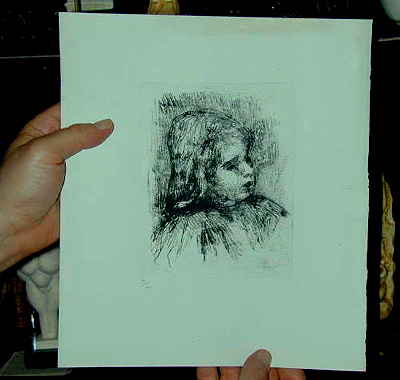
One more delicious Renoir Original for your delight. Please note the greenish color of the paper in the photo above, and also note that original oils, watercolors, sculptures, drawings and charcoals by any of these artists I’ve presented here would cost typically in the millions of dollars. Only by collecting works on paper, especially small editions of multiple signed prints, is affordable by any normal standards. If you’re an abnormally wealthy collector, I do happen to have some interesting items, but you’ll have to call ahead for an appointment. Here’s the most amazing Renoir original work on paper you’ll ever be offered:
PIERRE-AUGUST RENOIR — Stella 18 — CLAUDE RENOIR, DE TROIS-QUARTS A DROITE, 1908 — OF THE UTMOST RARITY, POSSIBLY UNIQUE. Softground etching, 1908, 162mm x 130mm to the platemark on 257mm x 294mm GREEN TINTED Holland Paper watermarked “D & C Blaucw” with the typical ornamental design within, some slight discoloration at the top right, due to age; no tears, no repairs, as issued thus. Two States in an edition of 100, most of which have been lost. PENCIL NUMBERED BY THE ARTIST, 9/100. A LIFETIME IMPRESSION, not stamp-signed by his sons following his death, as was typical of many of the surviving studio prints, some of which were below standard. This is a fine, rich impression on a very unusual paper, and therefore rare and possibly unique. Read on: This study of Renoir’s younger son Claude was originally a pencil-sketch made sometime in the summer of 1908, then a few months later, translated into the etching plate as we see it here. Only a very few proofs were pulled at this time, immediately following Renoir’s visit to his painter friend Victor Roux-Champion. At the end of Renoir’s life, a few impressions were pulled just to test the plate; then in 1923 or 1924 a full edition of 100 was printed and acquired by the famous French art dealer, Sagot. These impressions are numbered in two groups of 50, on different papers, usually a wove stock. This example is not wove, but laid. All impressions of this plate are now extremely rare, but this one — numbered 9/100 — is extraordinarily unique, quite possibly the only one of its kind in the world. THIS IS THE ONLY KNOWN SURVIVING IMPRESSION ON GREEN HOLLAND PAPER. Garrec records a similar impression on Green Holland, numbered 1/100, but it was reportedly lost in the fire-bombing of Dresden during World War II.
My price? It’s gallery-tagged at $138,500, far below what you’d have to pay for any other AUTHENTICATED Renoir unique on the marketplace today. Anyone acquiring this would have a very desirable potential museum donation that could have lots of publicity around it, if it were played right, block-buster style. How? If you want to create a great effect with your local museum the winner, you have but to ask how it’s done. But you must have the item in hand first. Why am I offering these wonderful art objects? Actually, I’m not. The secret is that they’re my loss-leaders, acquired over the past 55 years judiciously and carefully, to lend authority, credibility and interest to my fine art galleries (I’ve had several, along with 6 successful restaurants) and auctions, and I’ve never had a return of anything I’ve sold in the fine art field yet. Why? I make damn sure of my ground before I stand on it and defend it. My real use for these “Million-Dollar Loss-Leaders” is to bring folks to the auction, where they’ll learn about the artists and get a good, deep glimpse into the world of art history — they will be amused, interested and delighted at what they hear. I tell stories about the artists, jokes related to art, and more. The Blue Chip Art is there to tickle, amaze and astound, not to sell. Think about it. I sell my ONLY PAUL GAUGUIN ORIGINAL ETCHING. What am I going to do to get his name back into my auctions? Well, I have to buy a woodcut. They’re expensive, but my complaint is that everyone has them. What I want is “P.T. Barnum Appeal”, meaning a sexy, exciting, even thrilling art discovery, and the fact that it’s for sale to the highest bidder is equally amazing, astounding and thrilling wonder! So come and watch the fun this coming weekend at the MemFest. You don’t have to bid, just watch, and listen, and learn.
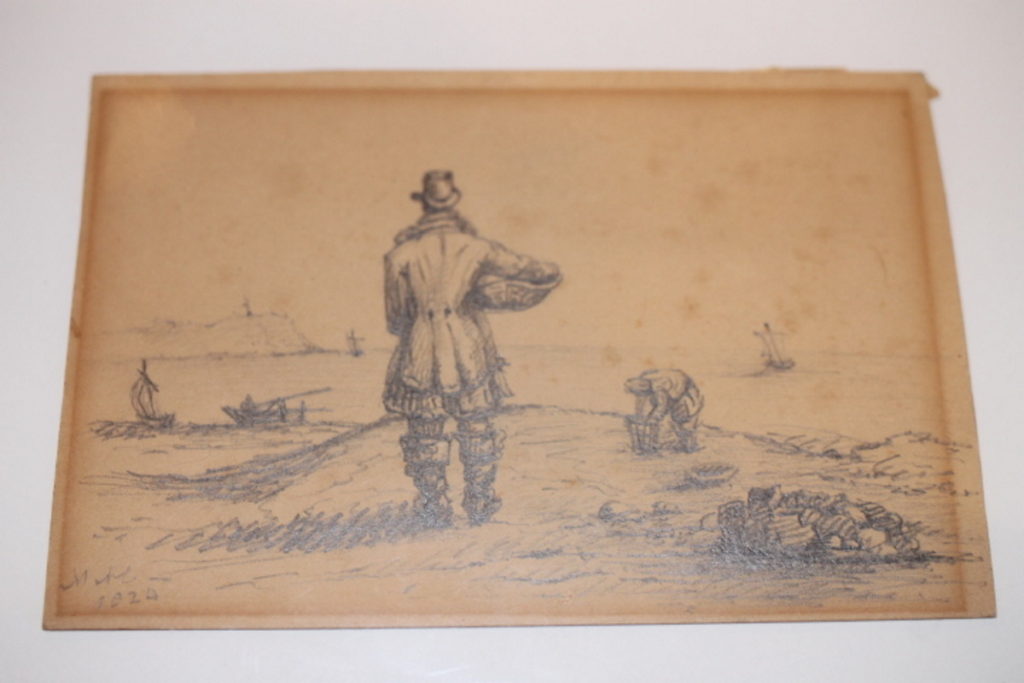
200 YEAR OLD GRAPHITE DRAWING 1825 — $3,850.00
So here you see a graphite drawing — there were no pencils, just sharpened sticks of graphite at the time. This RARE PUBLISHED original drawing is dated 1824. It was at that time transferred to a copper plate, which can be seen in “SEAFARING VOYAGES”, Pembley’s Publishing, London, 1825. Provenance, Pamela Hatay-Stratton.
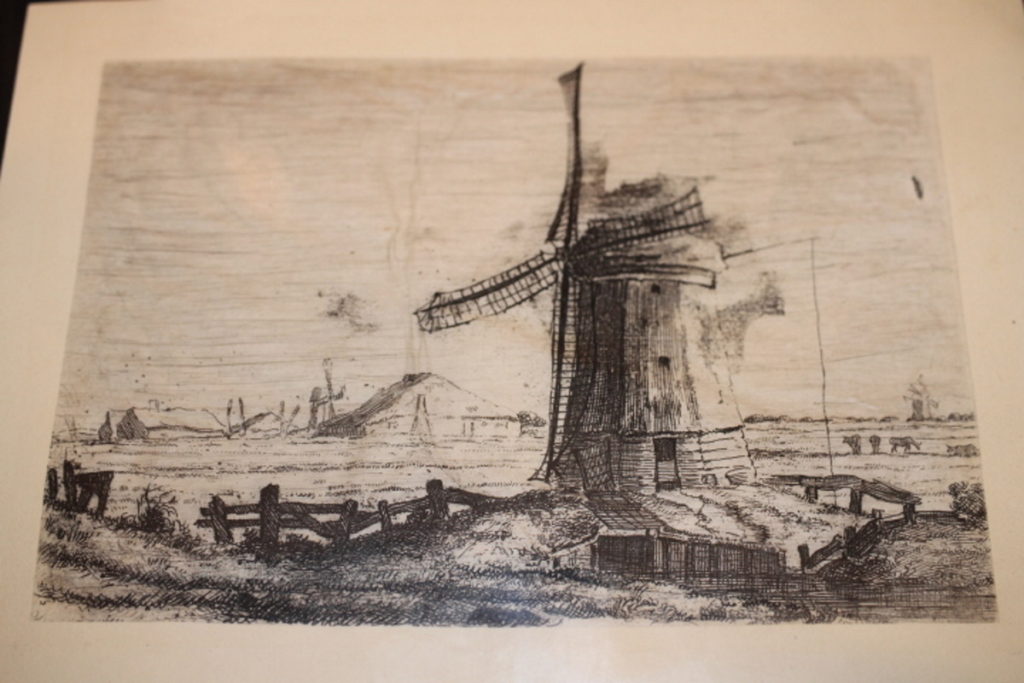
EDWARD MANET, “WINDMILL” — $2,200.00
This original Manet is an etching that is dated 1905. Technically, it’s an etching with aquatint printed on translucent “Foolscap Paper”, with some printing creases due to pressure of the etching roller. Professionally mounted by the printer onto Japan Paper for insertion into the book. There was a small edition of 100, printed in 1905. For reference, the catalog raisonne Number is 6084-T-BB.
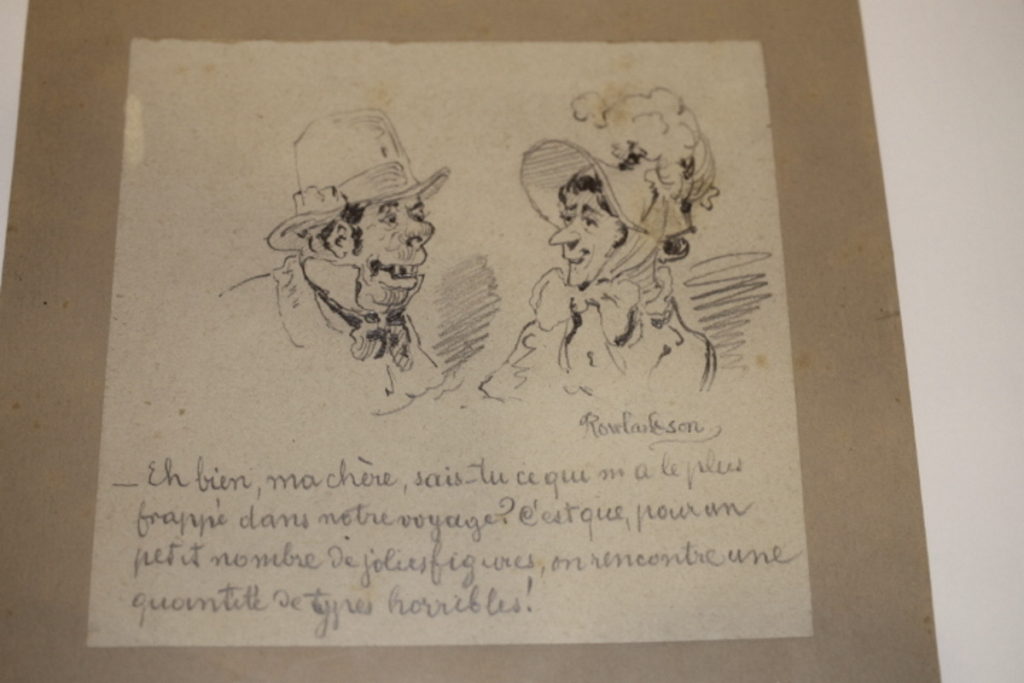
THOMAS ROWLANDSON, GRAPHITE DRAWING — $8,500.00
I have here an original Thomas Rowlandson graphite cartoon drawing which was included in a popular French magazine in 1793. It was republished in 1810, in a book about political and medical humor, which is outlined pretty definitively in wikipedia, which has a large entry on him. It is signed also in graphite on the lower right of the drawing, beneath the woman, and its provenance is Pamela Hatay-Stratton. The caption is in French 18th century French.
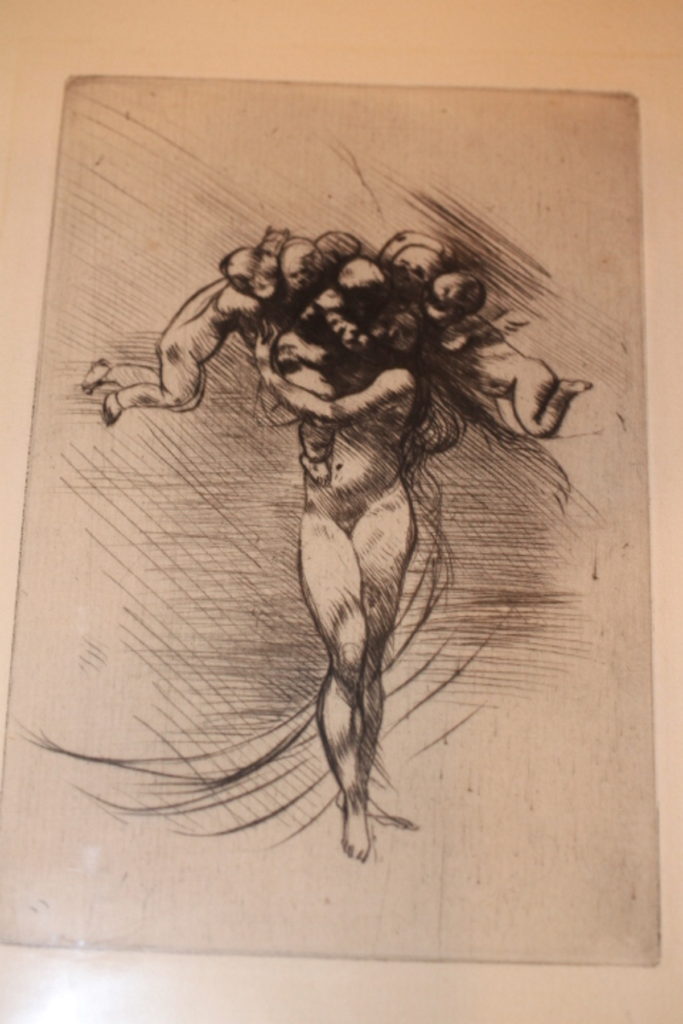
AUGUST RODIN “LE PRINTEMPS” — $1,850.00
Drypoint etching with heavy burr, indicating an early impression. Only State. Published in Gazette des Beaux Arts, 1902, Thorson iv, Delteil 4. Measures 5 1/4″ x 4″, from the collection of Pamela Hatay-Stratton, republished in Le Studio in 1903, but this earlier edition shows the heavy burr and pre-cleaning marginal toning, untrimmed and uncut margins and binding threads on left edge indicate the Beaux-Arts edition, thus RARE +++.
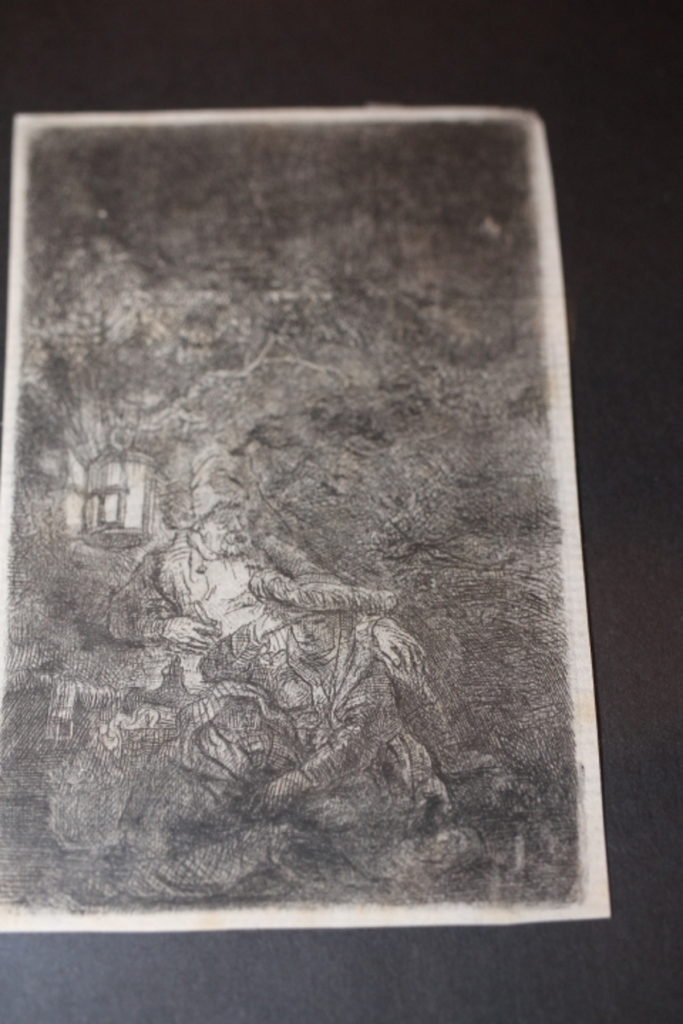
REMBRANDT B-57, “REST ON THE FLIGHT INTO EGYPT, A NIGHT PIECE” — $12,500.00
A small not very common night piece with dramatic appeal. Unsigned and undated, about 1644, plate still in existence in Paris. This is the FOURTH STATE of eight known States.
Ass’s head on right branch of tree unshaded, shading added on branch of tree, burr on added shading. Ass’s head added at right; horizontal shading added lower right corner, much extra horizontal shading added to even up the lower right edge, two tiny diagonal right-left marks in upper right corner found on all subsequent states, and before the Watelet Retouch.
Etching with drypoint, H.208/BB44-2. Provenance, Llandaff Family Collection, Pamela Hattay-Stratton Collection, Lugt 1805. Thread margins, plate 58mm x 91mm, outside dimensions 62mm x 95mm.
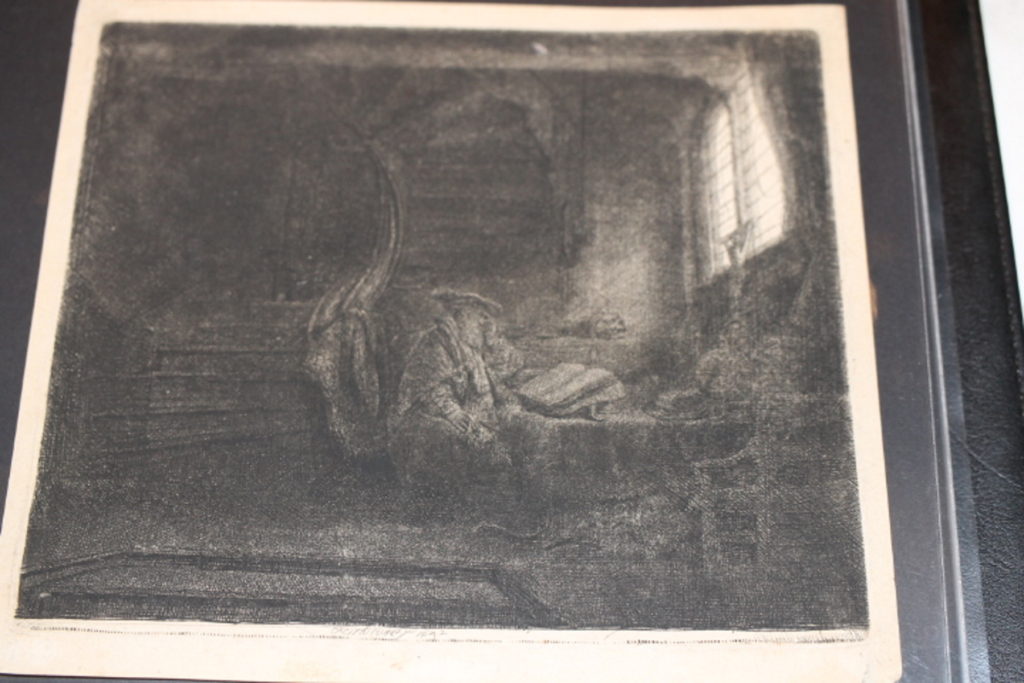
REMBRANDT “SAINT JEROME IN A DARK CHAMBER” — $12,500.00
B-105, a fairly common plate, but a very UNcommonly rich and fresh impression, signed and dated REmbrandt f. 1642, Amsterdam. The plate is still in existence.Signed and dated, this is W/B105 Second State, a fine and profoundly rich impression printed with tone on paper bearing the Seven Provinces watermark, as expected.
Lugt 953, an important and richly printed piece seldom seen with all details as clear and sharp as they are here — unfortunately, the photo does not capture this.
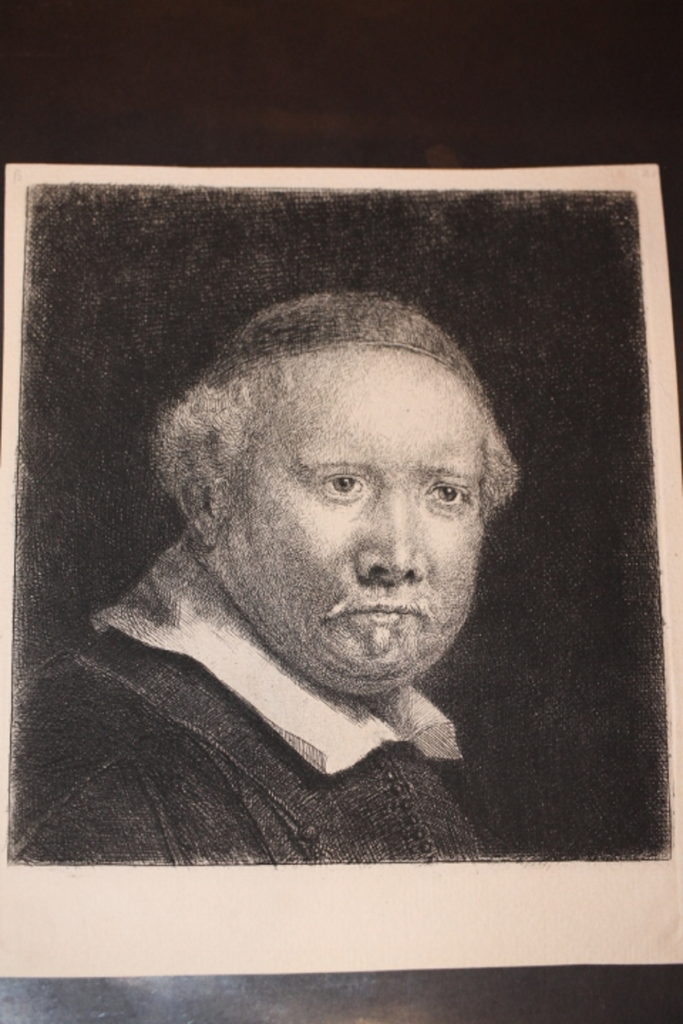
REMBRANDT “LIEVEN VAN COPPENOL WRITING MASTER” CUT PLATE — $1,850.00
B-283, a rare plate uncut, but the cut plate is seldom seen in as rich an impression as this one, unsigned and undated, about 1658. The cut-down plate is still in existence.
This is the NINTH STATE of eleven known States, and the large plate has now been cut down into 159mm x 133mm, head only, with no additional retouching. Background is very strong and dark, very rich tones, impression is sharp and clear, same as 8th State. Bjorkland state vi/vi, Hind vi/vi Nowell-Usticke has this state as ix/xi.
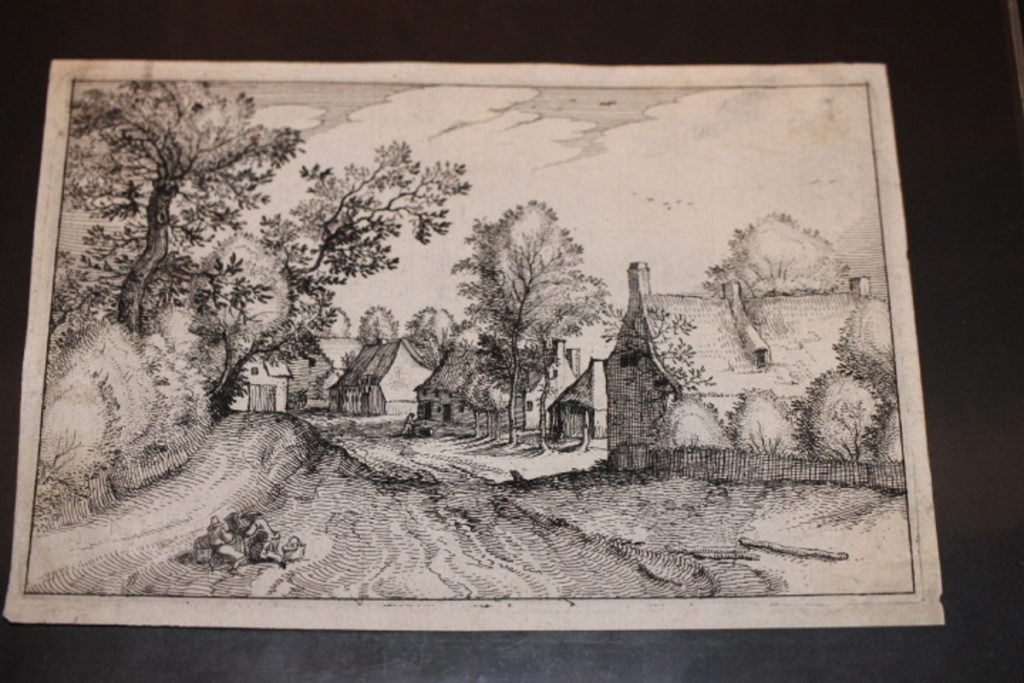
RUISDAEL “THREE PEASANTS WITH A ROW OF HOUSES” — $9,500.00
This unusual and delightful Ruisdael landscape etching is one of the finest and clearest impressions I have ever seen of it. The Japan paper is wide margins with no repairs, and is extremely hard-to-find in any condition. NO mounting marks that I can see on it.
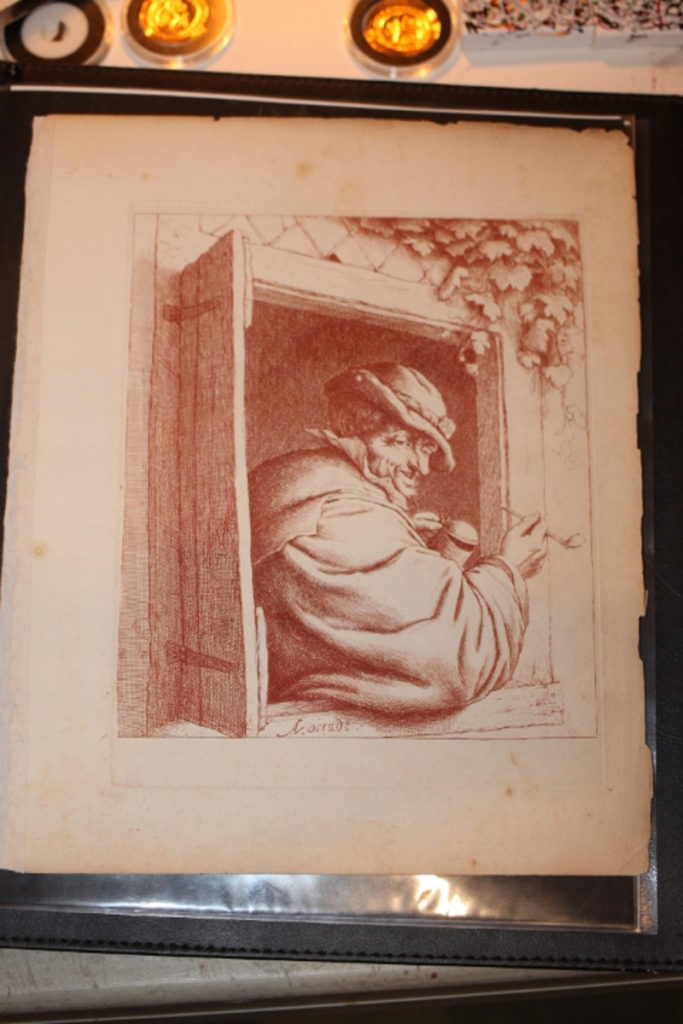
ADRIAEN VAN OSTADE “SMOKER AT THE WINDOW” — $38,500.00
An incredibly rich and fine posthumous sanguine-ink impression. I prefer the sanguine to the earlier black ink prints produced by Ostade in his lifetime. The sanguine prints are very superior, and really show off the fine etching work of Ostade, who was a great etcher, but a lousy printer.
No tears, no repairs, strongly printed with full wide book margins, with book mountings still in place, rare in this state, and perfect for a float-mounted presentation.
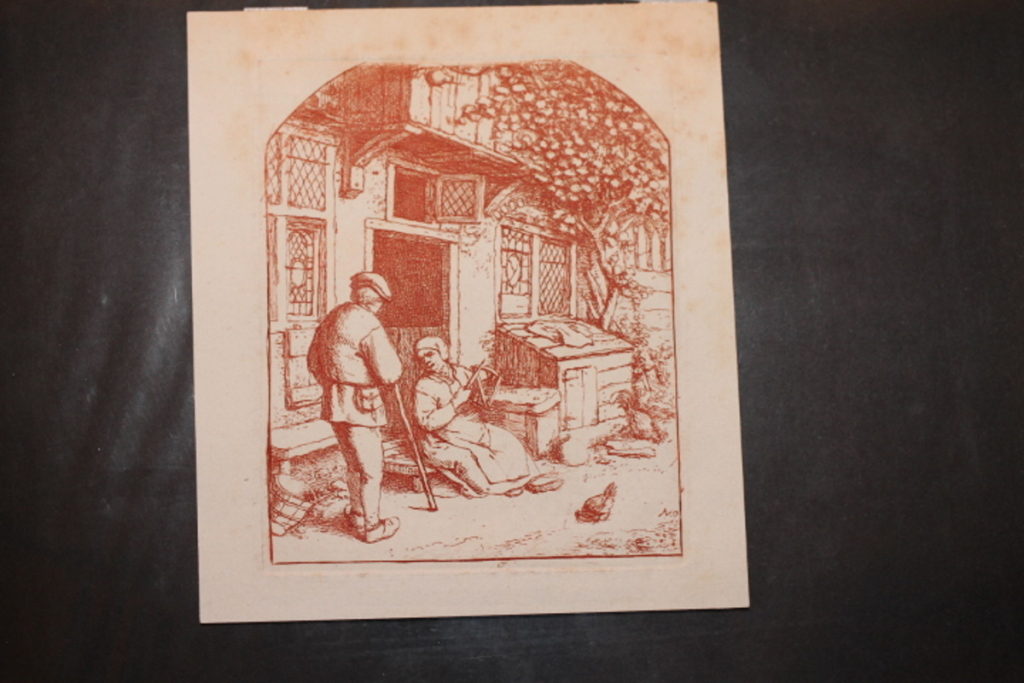
ADRIAN VAN OSTADE “WOMAN WINDING UPON A REEL” — $3,600.00
A fine, rich impression in sanguine ink on full margins Japan Paper. A beautiful and highly desirable etching circa 1650, no tears, no repairs, no stains and no foxing, rare thus.
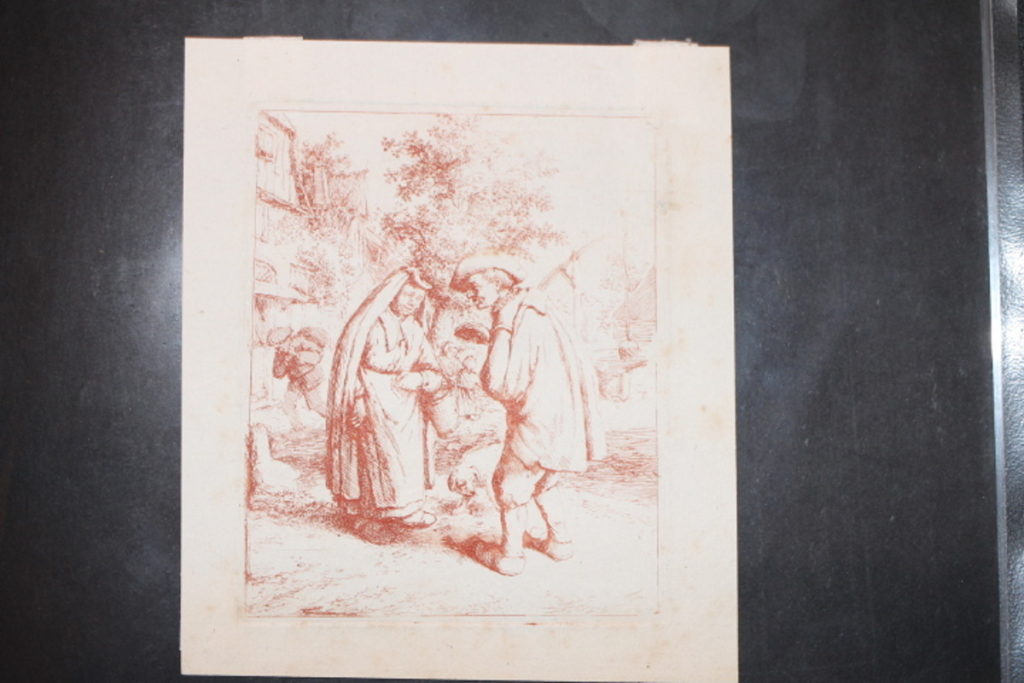
ADRIAEN VAN OSTADE “MAN & WOMAN CONVERSING IN THE STREET” — $3,600.00
A fine, rich impression with subtle tones, printed in sanguine ink on full margins Japan Paper. A beautiful and highly desirable etching circa 1650, no tears, no repairs, no stains and no foxing.
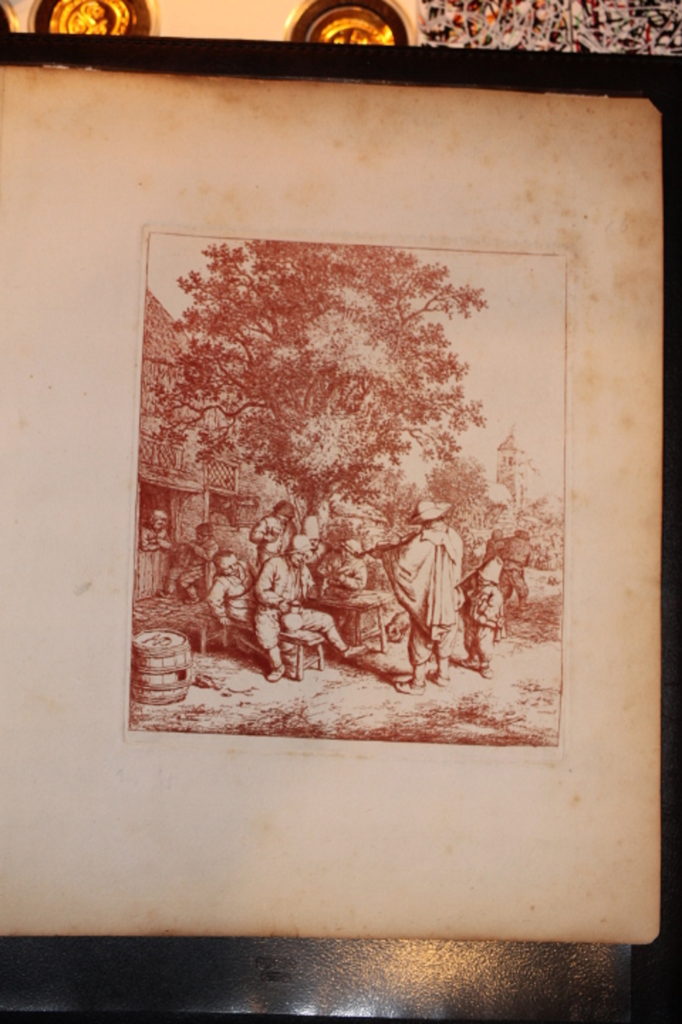
ADRIAEN VAN OSTADE “FIDDLER & HURDY GURDY BOY” — $38,500.00
An incredibly rich and fine posthumous sanguine-ink impression. I prefer the sanguine to the earlier black ink prints produced by Ostade in his lifetime. The sanguine prints are very superior, and really show off the fine etching work of Ostade, who was a great etcher, but a lousy printer.
No tears, no repairs, strongly printed with full wide book margins, with book mountings still in place, rare in this state, and perfect for a float-mounted presentation.
Well, that’s the lot. I’ll be posting these soon on eBay, once I’ve gotten up the stuff for a dollar — those are for YOU, so they’re my first priority. Dollar auctions must happen, and a lot of folks are happy today that they bid one dollar for what they got!!!
Okay, time to get back to the Godd Particle — we’re hoping things will go well in testing…
See You At The Top!!!
gorby

